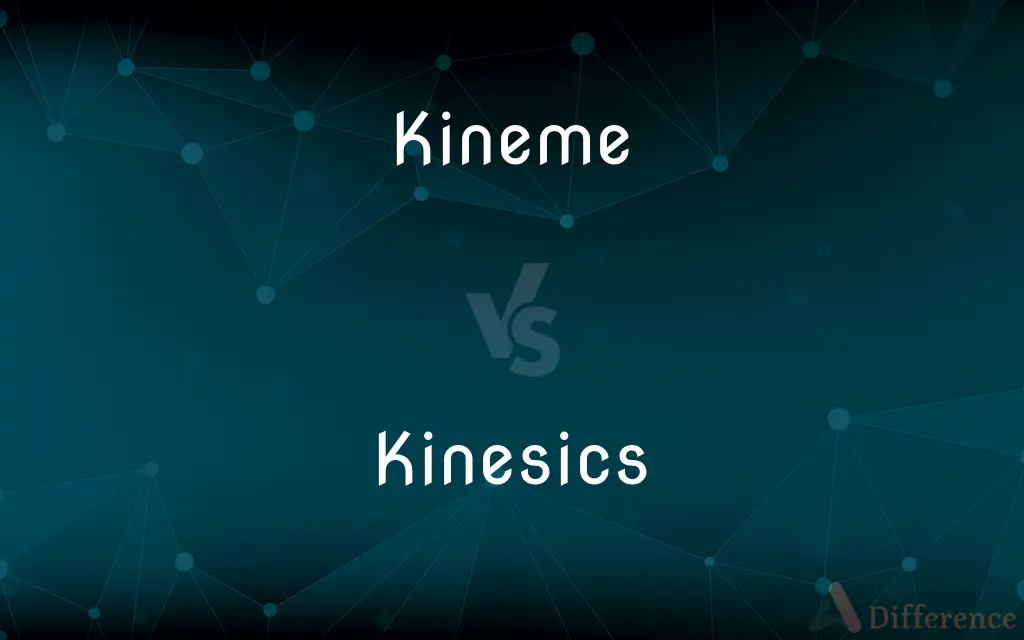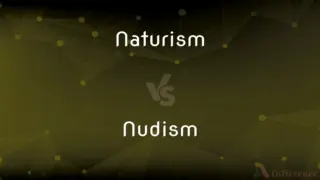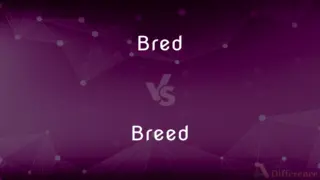Kineme vs. Kinesics — What's the Difference?
By Tayyaba Rehman & Urooj Arif — Updated on April 22, 2024
Kineme refers to the smallest unit of movement in non-verbal communication, focusing on individual gestures; kinesics studies the significance of body movements and gestures as a whole in communication.

Difference Between Kineme and Kinesics
Table of Contents
ADVERTISEMENT
Key Differences
Kineme represents the smallest functional unit used in non-verbal communication, similar to how phonemes function in spoken language. Whereas, kinesics is the study of how body movements and gestures function as a form of communication, considering the broader context and interpretation.
Kinemes are analyzed in terms of their individual characteristics and their role in conveying meaning through body movements. On the other hand, kinesics examines patterns and significance of these movements, assessing how they translate into communication effectively.
In kineme analysis, the focus is often on the technical decomposition of a gesture into its component parts. Conversely, kinesics involves understanding the holistic impact and cultural variations of body language across different social or interpersonal scenarios.
Kineme research might concentrate on the mechanics of a single gesture, such as a nod or shrug. Kinesics, however, extends to the interpretation of gesture sequences and their integration into verbal communication.
The study of kinemes can be crucial for technologies like motion capture and animation, where precise movements are replicated and studied. Kinesics plays a significant role in fields like psychology and anthropology, where understanding human behavior and social interaction through body language is essential.
ADVERTISEMENT
Comparison Chart
Definition
Smallest unit of movement in non-verbal communication.
Study of body movements as a form of communication.
Focus
Individual gestures.
Overall patterns and meanings of gestures.
Application
Motion capture, animation.
Psychology, anthropology.
Analysis Level
Micro-level (gestural elements).
Macro-level (contextual interpretation).
Relevance in Communication
Specific gestures' mechanics.
Broader social and cultural implications.
Compare with Definitions
Kineme
Basic unit of gestural expression.
A single kineme like a nod can signify agreement.
Kinesics
Field studying body language.
Kinesics reveals how posture can indicate confidence.
Kineme
Analyzed in kinesiology.
Kinemes are crucial in studying motion efficiency.
Kinesics
Essential in non-verbal communication studies.
Kinesics is fundamental in understanding human interaction.
Kineme
Used in bio-mechanical studies.
Each kineme's role is studied for ergonomic designs.
Kinesics
Analyzes gestures and movements.
In kinesics, a smile can be dissected into various emotional signals.
Kineme
Integral to sign language.
Kinemes differentiate meanings in signs.
Kinesics
Used in behavioral psychology.
Kinesics helps in identifying cues of deception.
Kineme
Component of non-verbal language.
Detecting kinemes helps in understanding silent expressions.
Kinesics
Applies to intercultural communication.
Kinesics varies significantly across cultures.
Kineme
(linguistics) In kinesics, a group of movements with an associated meaning, analogous to a phoneme in spoken language.
Kinesics
Kinesics is the interpretation of body motion communication such as facial expressions and gestures, nonverbal behavior related to movement of any part of the body or the body as a whole. The equivalent popular culture term is body language, a term Ray Birdwhistell, considered the founder of this area of study, neither used nor liked (on the grounds that what can be conveyed with the body does not meet the linguist's definition of language).
Kinesics
The study of nonlinguistic bodily movements, such as gestures and facial expressions, as a systematic mode of communication.
Kinesics
The study of non-verbal communication by means of gestures and/or other body movements.
Kinesics
Such non-verbal communication.
Body language
Common Curiosities
How does kinesics help in understanding communication?
Kinesics studies the use and meaning of body movements, helping decode non-verbal cues in communication.
How are kinemes useful in technology?
Kinemes are used in motion capture and animation to replicate precise human movements.
Can kinesics vary across different cultures?
Yes, interpretations and uses of body language can vary widely across cultures, a major focus of kinesics.
How does one study kinemes?
Studying kinemes involves analyzing individual gestures and their components to understand their communicative function.
How does knowledge of kinemes aid in sign language?
Understanding kinemes helps interpret and differentiate the specific gestures used in sign languages.
Are kinemes similar to phonemes?
Yes, kinemes are to non-verbal communication what phonemes are to spoken language, representing basic units.
What is a kineme?
A kineme is the smallest unit of movement used in non-verbal communication.
Why is kinesics important in non-verbal communication?
It's crucial for comprehensively understanding how body movements convey information and affect interpersonal interactions.
What insights does kinesics provide into human behavior?
Kinesics provides insights into emotional states, social interactions, and cultural norms through the study of body language.
What fields benefit from kinesics?
Fields like psychology, anthropology, and communication studies benefit from kinesics.
Is there a technology that specifically uses kinemes?
Yes, technologies like virtual reality and animation use kinemes to create realistic simulations of human movement.
Share Your Discovery

Previous Comparison
Naturism vs. Nudism
Next Comparison
Bred vs. BreedAuthor Spotlight
Written by
Tayyaba RehmanTayyaba Rehman is a distinguished writer, currently serving as a primary contributor to askdifference.com. As a researcher in semantics and etymology, Tayyaba's passion for the complexity of languages and their distinctions has found a perfect home on the platform. Tayyaba delves into the intricacies of language, distinguishing between commonly confused words and phrases, thereby providing clarity for readers worldwide.
Co-written by
Urooj ArifUrooj is a skilled content writer at Ask Difference, known for her exceptional ability to simplify complex topics into engaging and informative content. With a passion for research and a flair for clear, concise writing, she consistently delivers articles that resonate with our diverse audience.
















































